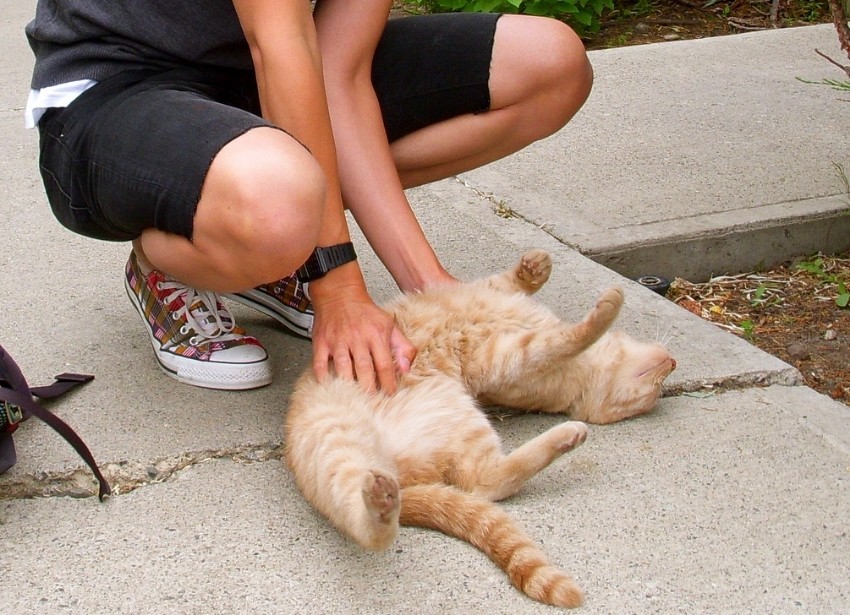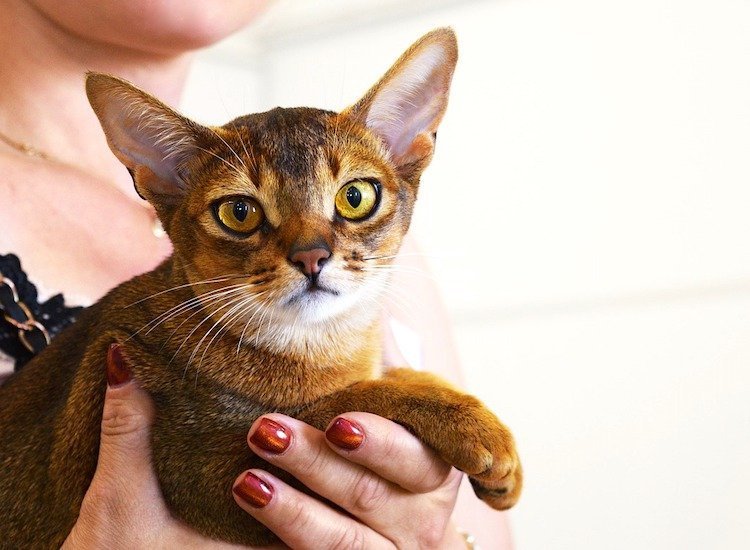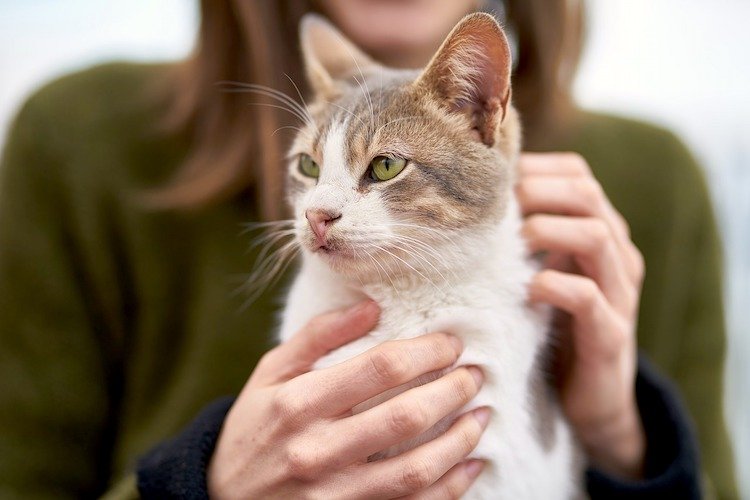This article was originally published in 2012 and is regularly updated. It was last reviewed for accuracy and updated on May 29, 2024

Unsure how to get a cat to like you? Cats show their affection in different ways from dogs, which is disappointing for some people who were hoping for a cuddly, affectionate kitty.
Although some cats are quite affectionate and will happily cuddle up in a warm lap, others are resistant to being petted, picked up, or cuddled.
Here are some ideas for bonding and achieving feline nirvana with your cat.
4 Ways on How to Get a Cat to Like You
Give your cat a ritual to look forward to.
Cats enjoy certain rituals just as we do. They appreciate the little understated gestures.
Bartholomew Oliver, a cat rescue worker in the Atlanta area, says she makes a point to give her cats “their own special greeting when I wake up or come home, just to let them know I’m glad to see them.”
Some of her cats like kisses, while others enjoy butt scratches. “But whatever their thing is, that’s what they get in hopes that it makes them feel wanted and valued,” Oliver says.
Rituals are “a great way to bond with your cat and demonstrate how much she means to you,” explains writer Julia Williams — even though some people would call her little cat rituals silly. “They are things I do daily with them, and I believe my cats would miss these rituals if they stopped. I would miss them, too.”
Massage your cat.
We find massage to be a good way of releasing stress — and so do cats. People don’t realize how stressed cats get. There are certain do’s and don’ts:
- Do be gentle and use the palms of your hands, not your fingertips.
- Don’t use massage oils or lotions.
Maryjean Ballner, a licensed massage therapist in New York, has been doing massages for cats for years. “Pet an animal, and you’ve made a friend for a day,” she says. “Massage an animal, and you’ve made a friend for life.”
Ballner believes that massage can “transform a temperamental tiger into a compliant kitty” and “socialize a scaredy cat.” That last one especially makes sense. Massage might be the first kind touch that an abused or poorly socialized cat has ever known.
Have a daily half-hour play session.
Cat toys give you a chance to really interact with your pet. Some cats have strong retrieving instincts, and throwing a small ball or a crumpled wad of paper sends them springing across the room like cheetahs.
If possible, try to set aside 30 minutes in the evening for play. It’s another ritual that will strengthen the bond between you.
Give your cat the gift of music.
Who knows? You may discover your cat loves music.
Producer Joshua Leeds and pianist Lisa Spector created a music series called Through a Cat’s Ear. The music is “designed to reduce stress in a chaotic or unsettling environment” and “provide sensory excitement for your indoor cat.”
Watch this pair of curious cuties react to music designed for kitties:
How to Get a Cat to Like You – Especially a Shy One
Bonding with a new cat takes time, but there are some things you can do to help the process along.
Make Your New Cat Feel Safe
Give them an area where they can be alone and feel safe.
- If you have an extra room, set it up for them with everything they will need: a litter box, food, water, toys, and bedding, and make sure that your other pets can’t get into this room.
- If you don’t have an extra room, simply set up a small area somewhere. Let your cat spend the first day or so in here, making sure to check in regularly to help start the bonding process.
Give them plenty of space.
After the first day or so when your cat starts to feel more comfortable, you can let them wander around your house, but always allow access to their “safe room.”
This is also one of the most important times of the bonding process. You don’t want your cat to feel overwhelmed — so although you should interact with them, don’t do it too often. When you do, try to get down to their level and, instead of forcing them to interact, let them make the first move.

Play with them
As soon as you think your cat feels comfortable, it’s time to start playing.
This is one of the best ways to bond with a new cat. After all, that is what they would do with their siblings if left alone.
Try to figure out which toys your cat likes best, and play using these toys at least once or twice a day. Your cat will start to associate being with you as fun.
Pet them
Once your new cat gets comfortable with your touch, go ahead and start petting them.
One of the most social behaviors between cats is grooming — and when you pet your cat, you are doing something similar (except with your hand instead of your tongue). This means it will make them feel comfortable and will clearly show your intentions.
While you pet them, talk in a reassuring, gentle voice.
Feeding time is bonding time
Another great way to bond with your new cat is through feeding.
Pick a certain time of the day for feeding and stick to it — your cat will quickly learn the schedule.
While feeding your cat, try to pet and talk to them as this will reinforce your bond. The goal while feeding is to make your cat feel special.
If you’re bringing a new cat home to live with your existing cats, see our article about keeping the peace in multi-cat households.

How to Get a Cat to Like You
If your cat is not naturally affectionate, there are some things you can do to bond with them to make your interactions together more positive. Your cat may never become a constant companion by your side like a dog would be, but you should be able to both give and get some affection from your cat eventually.
Until your cat is comfortable and happy, bonding will remain an issue.
One way to encourage affection from your cat is to make sure they have all they need to be healthy, happy, and comfortable:
- Clean the litter box often.
- Keep the drinking water fresh.
- Feed a high-quality cat food.
- Interact with your cat using fun toys.
- Provide opportunities for regular exercise.
While cats often prefer to choose their own sleeping place, buy a cat bed or have soft bedding available for yours to sleep on. Then try rubbing the bedding on you so that it picks up some of your scent.
The idea is your cat will start associating their safe resting area with your smell.
“The cat’s world is dominated by odors using marking scents, and in this manner, you will become an accepted part of their scent territory,” says Jasmine Kinnear, a cat behavior consultant, in her book Every Cat Has a Story. Kinnear says this works especially well with a skittish kitten.
Finally, a scratching post will provide a place for your cat to scratch — which will make them happy and prevent scratching on the furniture.
Once all of these basic needs have been met, and you’ve provided a calm, safe environment, your cat will become more relaxed and open to bonding with you.
Model Affection to Your Cat Using Your Voice and Touch
When you get up in the morning, if your cat doesn’t greet you, go find them and greet them.
If your cat is hiding, however, don’t disturb them. They will likely emerge when they are ready to eat, and the sound of a bag of food rattling or the can opener will draw them out.
Pet your cat, when allowed, and talk to them frequently so they get accustomed to it. They will already be associating you with food, which is a definite positive, and by stroking them gently and speaking softly, you’ll make your cat more comfortable around you.
When you come home from work, be sure to seek your cat out and show them some attention. “Remember that your cat has been alone for hours and will be looking forward to interacting with you,” writes cat behavior expert Pam Johnson-Bennett in her book Think Like a Cat.
Cats, like all animals, are creatures of habit. When your cat gets used to being close to you and being touched by you, they may learn to like it and return the affection.

Bonding With Your Cat Through Food
Your cat will be happy when you’re feeding them, so meals are the perfect time to show your cat some affection.
- Put the food in your cat’s bowl, and while your cat is eating, gently and unobtrusively pet them.
- Do this with every meal. Your cat may begin to associate the positive feeling they get from being fed with your touch as well.
Bonding With Your Cat Through Toys
If your cat is resistant when you try to pick them up, try playing with them instead:
Was YOUR Pet Food Recalled?
Check Now: Blue Buffalo • Science Diet • Purina • Wellness • 4health • Canine Carry Outs • Friskies • Taste of the Wild • See 200+ more brands…

- Dangle a wand toy for them to tug on.
- If they seem comfortable with you while you’re sitting on the floor, place them in your lap while you move the toy.
- Once your cat gets used to you being around while they’re playing, you’ll have more opportunities to pick them up and test the waters.
Sure, this may not be as good as being able to hug and cuddle your cat like a puppy, but it will be a form of physical bonding.
In a blog post on this subject, Johnson-Bennet writes, “Cats show affection in so many ways, and you might even not notice some of the more subtle ones.”
She adds: “Your cat doesn’t have to be a lap cat to be affectionate. She may enjoy sitting next to you or maybe even several inches away, but that doesn’t mean she’s not affectionate.”
Your Secret Weapon for a More Affectionate Cat: Treats and Catnip!
When your cat comes out of hiding and near you, reward them with a treat.
The idea, again, is to get your cat to associate you with positive feelings, and they may even begin to seek you out so they can get more treats.
Another idea: catnip. Simply put, most cats are crazy for catnip, and it can make them more affectionate and friendly as well.
“Catnip acts as a natural mood enhancer,” explains Hill’s Pet in a blog post. “It might make your cat act quite unusually; she may become more kittenish or particularly affectionate. She may also roll, paw or rub her face in the source of the catnip. Or she may jump about and become frisky, running from room to room appearing to chase invisible prey.”
So go ahead and give it a try: Sprinkle a pinch of dried catnip near your cat. Then, while your cat is rolling around and enjoying this aromatic herb, sneak in some soft petting. You and your cat will both enjoy the experience.

Do You Know How to Pet Your Cat?
We should also point out that you shouldn’t pet a cat like you would a dog. You probably already know this.
“Cats are purr-ticular about where and how they like to be touched,” says Dr. Marty Becker, DVM. “Scratch them between the ears or beneath the chin, rub that sweet spot between the eyes, or stroke them along the spine.”
If your cat starts bumping their head against you, that’s a great sign.
But, Dr. Becker adds, “avoid [petting] the belly and the base of the tail. Many cats feel vulnerable when their tummy is at risk, even if you’re not a threat to them.”
Johnson-Bennett agrees: “No belly rubs for the cat, please, or else you’ll trigger a defensive response.”
The video below offers some interesting “cat hacks” from Lifehacker on getting a cat to like you more:
Final Thoughts on How to Get a Cat to Like You
You might feel rejected if your cat doesn’t want to cuddle with you.
But understand that some cats — maybe even most of them — don’t show their affection in that way.
“What you may interpret as a cat being aloof is actually your exquisitely designed companion being ready for anything,” says Johnson-Bennet. “Just because your cat may not jump to immediate attention when you call her name, doesn’t mean she’s aloof — she’s focused.”
“So do not force it” when it comes to getting your cat to be more affectionate, adds well-known veterinarian Michael W. Fox.
Instead, he says, “Accept your cat for who she is and relate to her on her terms, petting and grooming her when she wants.”
Frequently Asked Questions (FAQ)
How to get a cat to like you?
Spend time interacting with your cat using gentle petting, play, and treats to build trust and affection.
How to get a cat to like you when it hates you?
Give the cat space, approach slowly, and use positive reinforcement with treats and toys to gradually earn its trust.
How to get a shy cat to like you?
Be patient and gentle, provide a safe environment, and use calm, quiet interactions to help the shy cat feel secure and comfortable.
How to get a stray cat to like you?
Offer food, water, and shelter, approach slowly, and allow the stray cat to come to you on its own terms to build trust.
References
- Williams, Julia. “Rituals Can Strengthen the Bond With Your Cat.” Canidae. Jan. 30, 2015. https://www.canidae.com/blog/2015/01/rituals-can-strengthen-the-bond-with-your-cat/.
- Kinnear, Jasmine. Every Cat Has a Story: True Stories Exploring the Spiritual Connection of Felines With Their Beloved Owners. CCB Publishing. 2007. 143. https://books.google.com/books?id=URDXHWOy3XQC&pg=PA143#v=onepage&q&f=false.
- Johnson-Bennett, Pam. Think Like a Cat: How to Raise a Well-Adjusted Cat — Not a Sour Puss. Penguin. 2011. https://books.google.com/books?id=I_oU6Ib9nt8C.
- Johnson-Bennett, Pam. “Cat Myth: Cats are Aloof and Independent.” Cat Behavior Associates. https://www.catbehaviorassociates.com/cat-myth-cats-are-aloof-and-independent/.
- “The Effects of Catnip on Your Cat.” Hill’s Pet Nutrition. June 13, 2019. https://www.hillspet.com/cat-care/nutrition-feeding/catnip-for-cats.
- Becker, Mary, DVM. “5 Ways to Turn Your Kitty Into a Lap Cat.” Vetstreet. April 6, 2015. http://www.vetstreet.com/dr-marty-becker/5-ways-to-turn-your-kitty-into-a-lap-cat.
- Fox, Michael W., BVetMed, MRCVS, PhD, DSc. “Can a Cat Who Is Not Affectionate, but Very Active and Inquisitive, Be Made to Be More Affectionate?” Washington Post. June 20, 2000. https://www.washingtonpost.com/wp-adv/liveonline/viewpoint/petcity/petcity620.htm.




